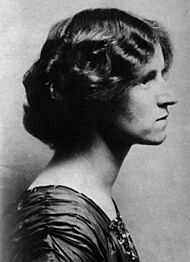Susan Sutherland Isaacs facts for kids
Quick facts for kids
Susan Sutherland Isaacs
|
|
|---|---|

Susan Isaacs, 1910s
|
|
| Born |
Susan Sutherland Fairhurst
24 May 1885 Turton, Lancashire, England
|
| Died | 12 October 1948 (aged 63) |
| Other names | Susan S. Brierley, Ursula Wise |
| Scientific career | |
| Fields | Educational psychology |
Susan Sutherland Isaacs (born Susan Sutherland Fairhurst, May 24, 1885 – October 12, 1948) was an important British expert in how children learn and grow. She was an educational psychologist and also a psychoanalyst.
Susan Isaacs believed that children learn best by being independent. She thought that playing was the most effective way for children to develop this independence. Adults and teachers, she felt, should guide children's play rather than just telling them what to do. Her ideas greatly influenced how young children are taught today.
Contents
Early Life and Education
Susan Isaacs was born in 1885 in Turton, Lancashire, England. Her father was a journalist and preacher. Her mother passed away when Susan was only six years old.
When she was 15, her father took her out of school. She had become interested in atheistic socialism, which her father did not approve of. They did not speak for two years. Susan stayed at home with her stepmother until she was 22. She first worked as a photographer's helper. Then, she started her teaching career as a governess for a family.
In 1907, Susan began training to be a teacher for young children at the University of Manchester. She later switched to a degree course and earned a first-class degree in Philosophy in 1912. She then received a scholarship to study at Newnham College, Cambridge, where she earned a master's degree in 1913.
Her Career and Ideas
Susan Isaacs also trained to be a psychoanalyst. This is a type of therapist who helps people understand their thoughts and feelings. She became a member of the British Psychoanalytical Society in 1921. She started her own practice in 1923. She also helped share the ideas of other famous thinkers like Melanie Klein, Jean Piaget, and Sigmund Freud.
Malting House School
From 1924 to 1927, Susan Isaacs was the head of the Malting House School in Cambridge. This was an experimental school. It focused on helping each child develop in their own way. Children at the school were given a lot of freedom. Teachers supported them instead of punishing them. The teachers saw themselves as observers. The children were like little researchers.
Her work at this school had a big impact on early education. It made play a central part of how children learn. Susan Isaacs strongly believed that play was a child's most important work.
Helping Parents
Between 1929 and 1940, Susan Isaacs wrote for child care magazines. She used the pen name "Ursula Wise." She answered questions from readers about problems they had with their children. This was like being an "agony aunt" for parents.
University Work
In 1933, she became the first head of the Child Development Department at the Institute of Education, University of London. Here, she created an advanced course for teachers of young children. Her department greatly influenced how teachers were trained. It encouraged them to think about children's feelings and how they develop.
Her Approach to Learning
Susan Isaacs believed it was important for children to learn to think clearly. She also thought they should be able to make their own independent choices. Developing a child's independence helps them grow as individuals. She saw parents as the first and most important teachers.
She believed children learned best through their own play. For Isaacs, play was like a continuous experiment. Children could explore new ideas and learn new things while playing.
Play should be seen as children's work. Interacting with others is also a very important part of play and learning. Children's feelings are also very important. Playing pretend or fantasy games could help children express their feelings. The role of adults was to guide children's play. But mostly, children should have the freedom to explore on their own. Her book Intellectual Growth in Young Children explains these ideas.
However, Isaacs did not think children should have complete freedom without any rules. She believed children needed to learn to control their own actions. This would stop them from harming themselves or others. She was also one of the first people to look closely at and question Jean Piaget's ideas about how children develop.
Personal Life
Susan Isaacs gave many lectures early in her career. She taught about infant education, logic, and psychology. In 1914, she married William Broadhurst Brierley, who was a botany lecturer. They moved to London a year later. There, she lectured in psychology at the University of London.
In 1922, she divorced Brierley. She then married Nathan Isaacs in 1922. Nathan Isaacs was a metals trader. He later worked with his wife on her research.
Later Life and Death
Susan Isaacs became ill with cancer in 1935. She struggled with her health for the rest of her life. Despite this, she was able to travel to Australia and New Zealand in 1937. After moving to Cambridge in 1939, she led a study called the Cambridge Evacuation Survey. This study looked at how being evacuated affected children during wartime.
She received an award called the Order of the British Empire (CBE) in 1948. Susan Isaacs passed away from cancer on October 12, 1948, at the age of 63. There are several pictures of her in the National Portrait Gallery in London.
See also
- Psychoanalysis
- Psychology
- Psychodynamics
- Early childhood education
- Parenting
- Pedagogy

